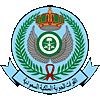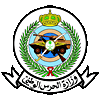That religion is very important in Saudi Arabia is also reflected in the Royal Saudi Armed Forces fin flashes which represent the legend "La Illaha Illa Allah wa Muhammad Ursul Allah" (There is no god but God and Mohammed in his prophet) written in Arabic writing that needs to be read from right to left.
Despite the fact that it is very hard to visit Saudi Arabia for Westerners, the Saudi forces are equipped with mainly western hardware. Main suppliers are the United States of America and the United Kingdom. When Iraq invaded Kuwait in 1990, the Saudis asked the USA to send troops to defend the kingdom and there has been a US presence in Saudi Arabia since. Both the UK (With BAE Systems as one of the prime contractors) and the US are involved in training programs conducted in Saudi Arabia.
For Middle Eastern standards the armed forces of Saudi Arabia are relatively small. Its strength however is derived from advanced technology and not from numerical superiority. This is why the armed forces are under a continuing modernization program. The backbone of the fighter force is formed by 134 Tornados from which a batch of 48 Tornado IDS was ordered in 1993 under the al-Yamamah II program and 72 F-15S aircraft delivered from the mid-90s that operate besides the 41 F-15C/D aircraft delivered in the early 90s. Aircraft training is executed on the Pilatus PC-9, BAe Hawk, Boeing F-15D Eagle and the Northrop F-5F Tiger II. Like in many other countries the C-130 is the mainstay of the Transport fleet and the Hercules is assisted by CASA CN-235s. Reconnaissance is performed by 17sq with their RF-5E and the Boeing E-3A is the Airborne Early Warning platform operated by 18sq.
The VIP support fleet of the Al-Saud family consists of a wide variety of civil registered aircraft such as the Boeing B707, B737 and B747, Lockheed Tri-Stars, MD11s and G1159A as well as Lockheed L-100-30. The HZ- prefix used in the civilian registrations of these aircraft derived from the former name of the territory (HejaZ)
The RSAF units are divided into Wings that are dispersed across the seven air bases. They are:
- RSAF Wing 1 at ?
- RSAF Wing 2 at Taif
- RSAF Wing 3 at Dharan
- RSAF Wing 4 at Riyadh
- RSAF Wing 5 at Khamis Mushayt
- RSAF Wing 6 at Al Karj
- RSAF Wing 7 at Tabuk
- RSAF Wing 8 at Jeddah
- RSAF Wing 11 at Dharan




